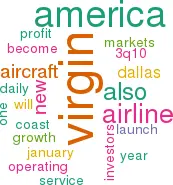Virgin America's bold growth move
Jan/Feb 2011


San Francisco–based LCC Virgin America started the year with a bang: a firm order for 60 A320s, valued at $5.1bn and including 30 “eco–efficient” A320neos (for which it became the launch customer), for delivery from 2013. This spectacular order and aircraft from other sources will more than triple its current 34–strong fleet to 111 aircraft by 2019.
A few days later, Virgin America made another bold announcement: it would triple its daily flights from the West Coast to Dallas Fort Worth, American’s stronghold, in April. The airline is also terminating its service to Toronto, which only began last June, in favour of focusing on immediate opportunities in markets such as Dallas.
Subsequently, on January 26, Virgin America announced that it would switch to the Sabre reservations platform from late 2011 – a move that will help build a robust and integrated systems infrastructure for the “significant growth” it forecasts. The airline also renewed its Sabre GDS agreement.
Clearly, Virgin America has ambitions to become a much bigger player in the US market. But its actions also hint of a new sense of urgency to grow and become profitable, after its slow and frustrating start. Its launch was delayed by two years due to questions about its ownership and control structure. Not long after it started flying in August 2007 there was the historic run–up in oil prices, followed by the global recession. Then in 2009 one of its founding investors exercised an option to sell their stake back to the UK–based Virgin Group, which led to complaints from other US airlines (primarily Alaska) and an almost yearlong DOT enquiry about the airline’s US citizenship status. During that enquiry Virgin America was unable to obtain any aircraft financing, so it lost about a year of growth. It also had to scramble to find new US investors.
After a successful recapitalisation, Virgin America received DOT clearance for its second “take–off” in January 2010. With the help of an additional $68.4m in unsecured debt obtained from shareholders, the airline began rounding up aircraft and announcing network expansion.
Since then the network has expanded from the previous transcon/West Coast focus (LAX, SFO, JFK, Washington DC, Boston, Ft. Lauderdale, Seattle, Las Vegas and San Diego) to include Orlando, Dallas Fort Worth, Toronto and two points in Mexico. The latest new city, Cancun, was added in January. The new destinations are typically linked to both LAX and SFO and have daily flights.
But difficulties in obtaining gates and slots at desirable airports have impeded Virgin America’s growth. In particular, the airline has long unsuccessfully sought access to Chicago O’Hare and Newark. In early February, however, there were reports that the city of Chicago was close to a deal to acquire several gates from Delta, which would open O’Hare to Virgin America and other new entrants.
The late–2009 recapitalisation brought back one of Virgin America’s original US investors, Cyrus Capital, in a bigger role (through a related entity), while some of the airline’s directors also put money in. One Virgin America executive said last year that the airline does not expect further shareholder funds until it reaches profitability. All of that would seem to suggest that Virgin America feels pressure to become profitable and complete an IPO at the earliest opportunity. Also, the airline will want to access the public markets (equity or debt) to fund the substantial orderbook.
After running up substantial losses since its launch, Virgin America achieved its first quarterly operating profit in 3Q09 and its first net profit in 3Q10. Operating margin in 3Q10 was a healthy 10.4%, reflecting strong RASM performance. The airline expected to post an operating profit for 2010.
Among LCCs, Virgin America is closest to industry–average RASM because of its full GDS participation, three–class service, upmarket product, extensive use of alliances and legacy–style revenue management. However, its cost and efficiency levels are also impressive: the 3Q10 ex–fuel CASM was 6.25 cents and daily aircraft utilisation 12.9 hours.
In addition to increasing fleet size, perhaps what is needed is to tweak the route structure, which is what the airline seems to be doing now. Like many other US LCCs, Virgin America, with its unique combination of low fares, upscale service and fresh and fun approach, may do best in large primary markets, such as West Coast to Dallas or Atlanta, where it can take on a high–cost legacy.